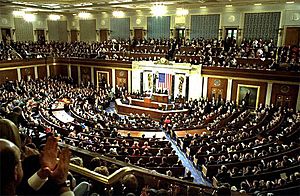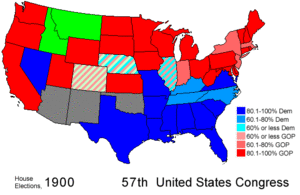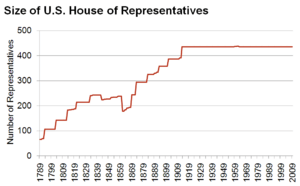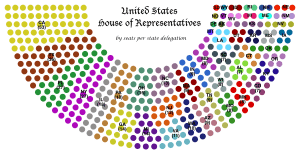History of the United States House of Representatives facts for kids

The United States House of Representatives is one of the two parts of the United States Congress. It works with the United States Senate to make laws for the country. The House is often called the "lower chamber," and the Senate is the "upper chamber." Both were created by the Constitution of the United States. The House first met on March 4, 1789, in New York City. Its story actually began even before that, during the American Revolutionary War.
Contents
How the House Began
Early Meetings: The Continental Congresses
Before the United States was officially a country, leaders from the American colonies met. The First Continental Congress gathered in 1774. They sent a list of complaints to King George III of Great Britain. When the King did not respond, the American Revolutionary War started.
In 1775, the Second Continental Congress met. A year later, on July 4, 1776, they declared the thirteen colonies free. This was the United States Declaration of Independence. The Second Continental Congress also wrote the country's first constitution, called the Articles of Confederation, in 1777.
Creating a New Government
Under the Articles of Confederation, the national government was weak. Each state had equal power, and they could often ignore national laws. This made it hard for the country to work together. So, in 1787, leaders met to create a stronger government.
One big debate was about how Congress should be set up. Some wanted states with more people to have more say. Others wanted all states to have equal power. They finally agreed on a plan called the Connecticut Compromise. This plan created two parts of Congress:
- The House of Representatives: Here, the number of representatives from each state would depend on its population.
- The Senate: Here, each state would have an equal number of representatives, no matter its size.
This new plan, the Constitution, was approved by the end of 1788. The House of Representatives officially began its work on April 1, 1789.
The House in the 18th and 19th Centuries
First Steps and Growth
When the House first started, it had 59 members from 11 states. Soon, more states joined, and the number of representatives grew. Frederick Muhlenberg became the first Speaker of the House. The Speaker is the leader of the House.
Growing Stronger
In the early 1800s, the House became more important. It started to have more power than the Senate. The northern states had more people, so they had more representatives in the House. This gave them a lot of influence.
During the American Civil War, a key leader in the House was Thaddeus Stevens. He helped create laws to pay for the war. He also worked on laws to rebuild the country after the war. Stevens was a very powerful Speaker.
After the Civil War, the two main political parties, Democrats and Republicans, often took turns controlling the House. Over time, members of the House stayed in office longer. This helped them become experts in different areas of lawmaking.
The House in the 20th and 21st Centuries
New Leaders and Firsts
In the early 1900s, the Speaker of the House became very powerful. Joseph Gurney Cannon was one such strong Speaker.
A big moment happened in 1916 when Jeannette Rankin was elected. She became the first woman to serve in Congress! Later, in 1973, Felda Looper became the first female page in the House.
Changes in Power
For many years, from the 1930s to the 1990s, the Democratic Party mostly controlled the House. This was during and after the Great Depression. A famous Democratic Speaker was Sam Rayburn.
In 1994, the Republican Party gained control of the House. This was a big change. Then, in 2006, the Democrats won back control. Nancy Pelosi became the first female Speaker of the House. The Republicans took control again in 2010, and kept it until 2018.
How Many Representatives?
The number of representatives in the House has changed over time. Congress decides how many members there should be. The number grew as new states joined the country and the population increased.
In 1911, Congress decided to cap the number of representatives at 435. This means there are always 435 seats in the House. These seats are divided among the states based on their population. Each state gets at least one representative, no matter how small its population is.
Some people today think the House should have more members. They argue that the U.S. population has grown a lot since 1911. More representatives might mean each one represents fewer people, making them closer to their voters.




